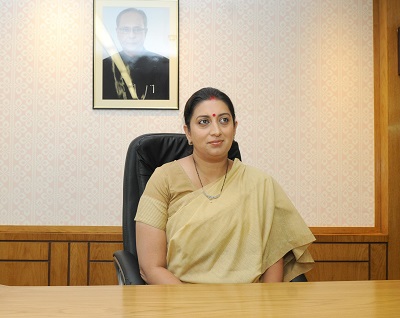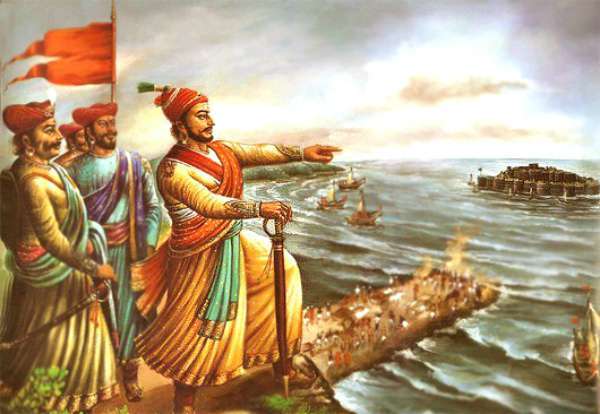Feminist and Media Discourse on Rape Protects Rapists
A group of friends whose friendship is thicker than blood
set out on a road trip. Sometime during the trip one of the men
sexually abuses and rapes one of the females in the group. If you happen
to be one of the members of this group what would you do? Help the
victim by driving the perpetrator straight to the police or conduct a
kangaroo court amongst your friends and suggest that the victim make
peace with the perpetrator for providing an apology?
The Leftist and Adarsh Liberals (
LAAL) opt for the later when the perpetrator is one of theirs.
Always.
They consider themselves feminists and champions of female emancipation
while in the long run always protect people from their camp who are
caught in grave crimes against women.
They have made feminism their war cry and have vitiated the Indian
society with their labels and vicious campaign on all issues related to
Indic culture and specially Hinduism. But when one of their own commits a
crime they think an atrocity is being committed against the
perpetratorwhen they are hauled to the court house.
The LAALcabal will jump up and down in derision when
Rakshabandhan, worship of women or addressing a woman as ‘Maa,’ ‘Beti’ are mentioned as part of Indian culture.
Kavita Krishnan the proud politburo member couldn’t
resist being nasty even for the simple campaign of #SelfiewithDaughter
which eventually went viral world over. She put out an insidious and
hateful tweet alleging the Prime Minister to be a stalker.
For the LAALs, their deep hate for everything Hinduism and one man, Narendra Modi, triumphs their core belief of feminism.
Let’s look at some of the alleged rape/ sexual harassment cases that
have occurred in the past and how this group has dealt with them.
Pink Chaddi
One of the recent cases of harassment that LAAL gang always likes to
remind as a successful campaign against misogyny is the Mangalore pub
incident. A few girls were harassed for drinking alcohol in bars.
Hooliganism was done by Ram Sene members with Muthalik at its helm.
The subsequent Pink Chaddi campaign and maligning of everything
Hinduism/ RSS/ BJP all because of the name ‘Ram Sene’ by every LAAL
member worth her salt is legendary. You basically had received
membership to the cozy LAAL group if you had either sent Pink underwear
to Muthalik or even written a blog post screaming how patriarchal/
regressive/ illiberal Hindus are for forcing their rules in a democratic
country.
The then ruling BJP government of Karnataka immediately swung into
action and booked cases against Muthalik. But every Op-ed and the
messaging from the UPA-II Central Government was to portray Muthalik as a
part of RSS and hence BJP which was in power at that time in Karnataka.
The incident was used to create fear mongering amongst urban folks
that “BJP is a regressive party which wants to foster goons like
Muthalik” while the truth was that he had been thrown out of RSS and its
allied groups long before the incident happened.
The LAAL cabal succeeded to such an extent in their fear mongering
that the BJP lost power in Karnataka in subsequent election cycle.
Let’s come to the present day. Last week, the media reported that the
current Congress government of Karnataka was considering dropping the
cases against Muthalik. The reason being cited: apparently he is no
longer a member of RSS. This happened a week ago and we are yet to see
any high decibel drama on the evening news media or harsh opinion pieces
demanding justice for the Mangalore pub victim.
Former
Tehelka journalist
Nisha Susan, the
brain behind the Pink Chaddi campaign,currently seems to have lost her
pen. Don’t hold your breath in the hopes of her finding it any soon.
The victims of this incident haven’t received any justice from the
judiciary. There is no doubt that hooliganism and moral policing should
not be tolerated.
But the LAAL brigade and the media use such
incidents only to malign and misinform rather than work towards bringing
justice to the victims. They used the incident to make a
tenuous connect between Muthalik –RSS and BJP and create fear of
infringement of rights and moral policing.
Underage Trafficking in Kerala
In November2014, a report by JaiHind TV in Kerala about an alleged
underage sex trafficking at a café house resulted in thrashing of the
place by Yuvamorcha group.
The LAAL group including the media and web based news portals quickly
latched on to the hooliganism incident and painted it as a moral
policing issue.
A campaign called #KissofLove was set in motion.
Opinion pieces and blog posts by all and sundry including the actor
Mohanlal were published. The campaign received political patronage from the local MLA and
AamAadmi Party. All the
sleeper cells were activated in unison as the clarion call of #KissofLove was called
out.
Each endorsement starting with local CPM Leader to the famous actor
created a chain reaction and the news was slurped right away by the JNU
brigade and English media in New Delhi who left no stone unturned to
beat Hindus as being regressive.
The incident had happened in Kochi but public demonstrations of #KissofLove were organized in many places outside
Kerala.
The campaign idea like the Pink Chaddi campaign had supposedly gone
viral. Someone who had no idea of Indian Metro culture, only read about
the campaign and watched TV news, would believe India was being ruled
by Sharia law which disallowed any public displays of affection: such
was the tenor of the campaign.
In all the manufactured noise, one vital piece of information was sidelined and forgotten-
What was the reason for Yuva Morcha to become so irate?
As reported by the local news channel,
the Café House which
the YuvaMorcha had stormed was suspected of being a heaven for immoral
trafficking using minor girl students. Thankfully, the police
had not forgotten about it. They continued to diligently do their work.
After a year, the Kerala Police arrested the main organisers of the
#KissofLove campaign for Prostitution and Child sex trafficking.
The main pimp and organizer
Rahul Pashupalan used his wife’s nude photographs to attract clients. Pashupalanand his wife
Reshmi Nair had been the prominent face of the #KissofLove campaign.
During interrogation, Reshmi Nair confessed to her crimes but is
reported to have also mentioned being coerced into posing nude and
soliciting clients by her husband. There were no debates on TV and no
raging opinion pieces published on the criminal activities of the main
players of the drama.
The LAAL group put out a
tepid
explanation distancing themselves from Pashupalan and Nair. The couple
was engaged in luring clients and trafficking young underage girls from
different cities even outside Kerala. This is a grave crime.
In any other situation the LAAL gang would have gone after the
government for information on the details of any story but here there
has been total silence. No human stories on how the girl child is
dealing with the trauma of being pushed in to prostitution. No story on
how or where were these young girls trapped and convinced to travel to
another city for flesh trade.
Narrative on Nirbhaya Rape
Nilanjana Roy, the leader of the left liberal
feminists in India, wrote an article on the Nirbhaya incident blaming
Hindu scriptures for the brutal rape of a young girl. The five-part
skewering response by Sandeep B to her article became a legend in the
world of take downs.
While Nilanjana’s unflinching support to feminist causes is well
known, many maybe unaware of her singular support to former Penguin
India head,
David Davidar who was accused of sexual harassment by a Canadian co-worker. Roy insisted on Davidar’s character being spotless even as he
himself admitted to the alleged harassment. Davidar lost his job with his Canadian employer and seems to have returned to India.
His career also seems to have been suitably
resurrected with no mentions nay whispers of his alleged misbehavior in the past though this article interestingly mentions “
A
second factor is simply Davidar’s profile among women in his circle in
India. He had several consensual relationships, according to former
colleagues. Women he’s worked with describe him as “passionate,”
“magnetic” and “charismatic.”
Rampant Sexual Harassment at Jawaharlal Nehru University
Jawaharlal Nehru University, the bastion of feminists and
Hate India-Hate Hindu (HI-HH) cabal has the highest number of reported
cases of sexual harassment on its campus but most of these stories are suppressed in the media.
IndiaFacts has run many exposes of sexual harassment and abuse of women in its
#JNUChronicles series.
The latest story that broke out is a serious crime against a female student and involves a faculty member of JNU.
It was first highlighted by ex-JNU student @navfrn in a blog post
here.
A foreign student was sodomised by her faculty advisor by asking her to meet at midnight in a secluded area.
As per norms, the student complained to the University’s internal
enquiry commission, the Gender Sensitization Committee Against Sexual
Harassment (GSCASH). The girl was so traumatised that she left her
studies midway and returned to her country.
In reality, the GSCASH is the Khap Panchayat of JNU. The mainstream media is not reporting significant details of the case. Tweets from JNU
students expose the brutality the girl faced and went into a shock after her rape.
Apparently, she was so scared that she even refused to file an FIR.
The GSCASH is an internal committee consisting of the JNU faculty and
elected student representatives. The election of student representatives
for GSCASH is a fierce ideological battle even though technically, one
would expect that such an organization would be free of any particular
political or religious ideology.
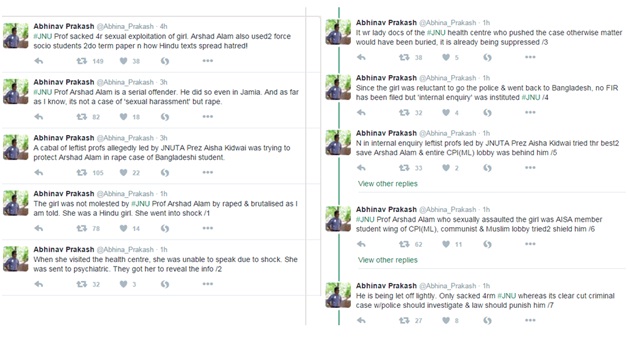
This
news report
on the elections of student representative for GSCHA suggests that
students from SFI, an affiliate of CPIM, and AISF, an affiliate of CPIML
are more concerned about supposed patriarchal control by Hindu men than
impartial justice.
“From gharwapsi to love jihad
BJP-RSS-VHP-Bajrang Dal combined are working relentlessly to strengthen
the control of patriarchy over the lives of women and undermining
movements towards democratization of gender relations. So GSCASH can
serve as a vital bulwark against such reactionary politics,” said Salini
, who is the representative of SFI.
With such prejudices set hard in the minds of the committee members,
one doubts the efficacy and the unbiasedness of justice that may be
eventually agreed upon by GSCHA committee. One wonders how the committee
will react if the perpetrator is a Hindu man with pro-BJP views versus
someone with anti-BJP views.
The religious bigotry of the student members is exposed when they
confine their enemy to only the RSS-VHP while routine Shariasque fatwas
announced by Muslim clergy are being completely ignored by the
representatives.
The alleged Professor had a history of sexual harassment offences
against him but it looks like he was let off with a light rap on his
wrist.
In the JNU case, while the girl did not file any police case it
appears that the University has been forced to terminate the Professor
based on the report of GSCASH. The termination happened only after the
University was pressurized to do so by other student bodies.
If one connects the dots it looks like the high number of reported
cases amongst 104 Universities, and a mention in the Lok Sabha by the
HRD minister on the
statistics
may have forced the University to act against the wishes of the JNU
Teaching Association (JNUTA) who equivocally resisted his termination.
Guru Brahma Guru Vishnu
Guru Devo Maheshwara
Guru Sakshat Param Brahma
Tasmai Shri GuraveNamah
In Hindu culture we consider the teacher/advisor our Guru and regard
him/her as a reverential figure. The Professor misused his position of
power, the trust and respect placed by the student in him.
As per the Sexual Harassment Act of 2013, the said crime has violated
the woman in multiple ways and yet the JNUTA is spending its energies
in protecting the perpetrator. The SHA is a far more stringent Act than
the earlier law and calls for strict punishment if a man uses his
position to intimidate or abuse a woman.
The rape in itself carries a lesser punishment than intimidation and use of power.
JNU has directed its students to not publicize the case citing violations of the GSCASH guidelines. Long before the case was reported by media,
Kavita Krishnan tried to intimidate @navfrn to remove his blog post.
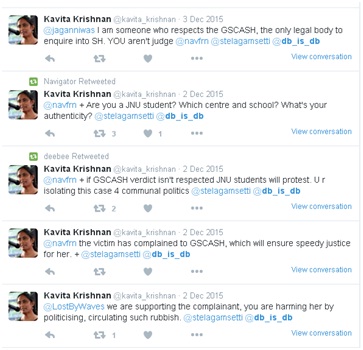 The GSCASH is a redressal system, not a legal body sanctioned
to hand out the final justice to a victim or penalise the alleged
criminal
The GSCASH is a redressal system, not a legal body sanctioned
to hand out the final justice to a victim or penalise the alleged
criminal. The home page of
GSCASH says:
“
Following the guidelines on the prevention and deterrence of
sexual harassment in the workplace laid down by the Supreme Court of
India in its 13 August 1997 judgment on the Writ Petition (Criminal)
Vishaka vs. State of Rajasthan, the Vice-chancellor of JNU appointed a
Working Group on Sexual Harassment headed by Professor KarunaChanana on 5
September 1997.”
It should be noted that the Sexual Harassment Act of 2013 now
supersedes the Vishaka Guidelines and this fact should have been noted
on the GSCASH webpage. The legal impact of these changes on the rules
and regulations of GSCASH are a separate matter.
By asking faculty and students to keep the cases confidential, JNU
and the LAAL group is attempting to hide their comrade’s heinous acts of
crime. A rape case of such proportions should entail a legal punishment
as provided in SHA.
In the communication sent out to curb publicity of the case, JNU has said “
such
acts tantamount to grave violation of privacy of those who have
entrusted faith in GSCASH. Any such incident should be reported to
GSCASH instead of publicising. This will further aggravate and amplify
the sufferings of the concerned and will have a detrimental effect on
mental peace and tranquility“.
GSCASH is not an apex legal body. In fact, instead of only an internal enquiry committee report, the JNU should be reporting the case to the police.
Feminism calls for nurturing courageous women and a society that is
conducive to such nurture. It does not call for women to be fearful of
the society because they have been raped. By using language like “
detrimental effect on mental peace and tranquility”
in their communication, the University is dissuading the victim and
women in general from being encouraged to report the crime. It is
tantamount to exploitation and intimidation of the victim.
How the LAAL Brigade Protects Rapists
Why does the LAAL cabal want to protect a serial offender?
When they arrange huge crowds and candle marches for women’s rights
and laws to protect women, are they doing so only to stigmatise and
break down the Hindu culture that they hate? Don’t the laws hold good
for their comrades? Or is it that the victimized women are only a tool
for them to further an agenda of Hindu hatred?
To understand how JNU functions if the tables are turned and the victim is a faculty member do read this
link.
There are many rape and heinous abuse cases that occurred in the past
few years but have been swept under the rug or under reported because
of powerful connections to the LAAL brigade. Two of them occurred in
West Bengal:
the Suzette Jordan case and
Tuktuki Mondal.
Last year in March 2015, Suzette Jordan of the Calcutta bar rape
case, died due to prolonged illness. On Twitter, her death played out
almost as expected with media trying to trend #JusticeforSuzette
attempting to allude that justice was denied to her by the current
government at the Centre.
The usual Candle Light Brigade was out in full force on social media
and a candle light vigil was held for her in New Delhi. The incident had
occurred in 2013. Mamata Banerjee, the Chief Minister of West
Bengal,attempted to stall the investigations by transferring the lady
officer in charge of the investigations who had succeeded in arresting
three of the five perpetrators.
The Chief Minister also tried to malign the victim by implying that
the incident is cooked up and false. In any other circumstances the
media and the LAAL brigade would have kicked up a storm against such
utterances by a Chief Minister but for some reason it chose to remain
quiet now.
Overall, insufficient exposure was given to the methods adopted by
the CM in pursuing the case to bring justice to the victim. After
Suzette’s death, the LAAL brigade attempted to turn the tables by
blaming the society and creating false
narratives of only a few standing by the victim.
In essence, the case was distorted as a blot on the society rather
than expose the system which had let her down. A good ploy by LAAL
comrades to make others feel guilty rather than work to make the system
foolproof.
The
Tuktuki Mondal case came into limelight due to
the perseverance of courageous people on social media rather than the
mainstream media or the feminist brigade. Again, the West Bengal CM
tried to sweep the case under the rug by giving excuses that the girl
was an adult and had left home on her own will. However,
the victim was only 14 years old and had been abducted by Muslim rogues. There was no media limelight or Op-eds written to pressure to the WB government to clean up their act.
An extremely heinous murder and a case of Love Jihad took place in
Kerala in 2015 but nobody from the LAAL brigade spoke out nor the
mainstream media carried any investigative reports on the same. A young
girl was trapped into a relationship and was being forced to convert to
Islam.

Her reluctance to convert led to her murder allegedly by her live-in
partner and member of the outfit ‘Popular Front’ which many consider as
the resurrection of the banned outfit ‘Students Islamic Movement of
India (SIMI)’.
The accompanying picture says everything but our vocal feminists seem
to have developed laryngitis over this incident. If such a heinous and
barbaric crime had been carried out by a pro-Hindu outfit member, the
hue and cry created by phony feminists from
Kavita Krishnan to
Shabana Azmi would have been earth shattering.
Eminent Feminists in Mainstream Media
Sunetra Choudhary, NDTV reporter, had written
extensively about sexual harassment by a well known UPA minister. It is
interesting that she wrote about her ordeal in
DNA and not in NDTV, her own channel.
Evidently, her employer whose tagline is “Experience the Truth”
didn’t want to deal with the reality faced by their own employee.
Sunetra also
mentioned her fear of meeting the alleged politician for an upcoming public function
“I should mention that I’m probably going to be bumping into the
perv soon. It’s inevitable with me being a political journalist, isn’t
it? There’s a planned public event where he’s slotted to appear and I
admit, that there’s a part of me that’s very scared about meeting him
again. But then I remind myself, I have done nothing wrong and if anything, it’s the perv who should be hiding, not me”.
Yet, neither NDTV nor
Barkha Dutt, the fiery
feminist chose to take any action after Sunetra’s first article. We are
left to wonder why a journalist is unable to present her case to the
public on her own employer’s website.
Recollect NDTV’s drama on the suppression of Freedom of Expression when the current government banned it from airing
India’s Daughter
due to legal issues? NDTV took the high road of exposing India’s
attitude to women and sexual harassment by insisting on broadcasting the
documentary while history shows that they apparently care less for the
safety of their own employee.
A young female employee of Greenpeace India struggled to get
attention
to her case of sexual harassment and rape by a male employee of the
organization. The victim’s faith in her colleagues and in the
institution were shattered when Greenpeace took no cognizance of her
complaint.
“I’d had such implicit trust in
my fellow campaigners, activists and social workers that I never
thought I’d have to familiarize myself with the mechanism of harassment
complaints. When I got over my initial hesitations
(fearing the resulting tensions,) and filed an official complaint two
months after the incident, there was no follow-up, and no verbal or
written communication that year, or the year after that. Vishaka
Guidelines and the subsequent act, The 2013 Sexual Harassment of Women at Workplace Act clearly
instructs the ICC to carry out an internal investigation and gather
evidence, neither of which was done. Instead, my harasser denied the
entire incident, saying that ‘he didn’t mean it in that way!’ The
official ‘punishment’ involved swapping his role with another
colleague’s. I was told a man should get a second chance, even though
two other female colleagues of mine had fallen victim to my harasser
before me, which the senior management was fully aware of. In 2015, the
senior management ordered my harasser to apologize to me through this
email (supposedly the “penance” that “lacerates” him)”
Greenpeace, a worldwide organization whose motto is
to protect the environment and the environmental rights of people seems
to have a very poor mission statement for women’s rights and safety.
Are
women lower in dignity than the environment or are Greenpeace female
employees not entitled to any justice and redressal system?
Though eventually Greenpeace did remove its senior management
employee who was in charge of redressal, it seems too late and too
little. As per SHA 2013, the findings of ICC should be eventually shared
with local authorities, especially in the case of rape allegations.
Based on reports available, no legal penalty has been sought in this
case so far.
Khurshid Anwar, a well-known Delhi activist and Director of Institute for Social Justice
committed suicide following charges of rape by a woman colleague.
Seema Mustafa wrote a
column
maligning the victim even as police investigations were being carried
out. The victim claims that her bosses discouraged her from undergoing
medical examination when she reported her ordeal to them. The victim in
fact has alleged that her bosses washed her clothes to destroy evidence.
This incident happened in 2013, a year after the Nirbhaya case and
almost around the time SHA came into being a law.
Tarun Tejpal Case Exposes the Feminist-Mainstream Narrative
The TarunTejpal case has become a legend of epic proportions.
Tejpal, one of the kingpins of the LAAL cabal used
his position as the boss to coerce and attempt to rape his junior female
employee. He later used his position to intimidate the victim by
agreeing to do “a penance that lacerates” by being away from the
organisation for a small period of time.
The Storify put together by
@Barbarindian
on the Tejpal case is a must read to understand how the LAAL cabal
reacted to the crime and went on an overdrive to protect Tejpal.
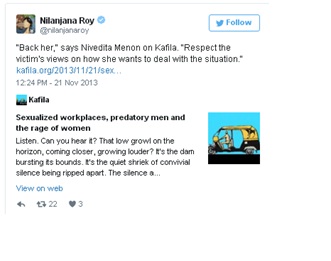 Compare the “respect the victim’s view on how she wants to deal with the situation”
Compare the “respect the victim’s view on how she wants to deal with the situation” with
how the mainstream media and LAAL whipped up a frenzy when the woman
who was allegedly snooped on by the Gujarat government did not want to
cooperate with the police.
Kavita Krishnan has
written:
“This isn’t about whether the woman and her dad today claim that
they are okay with having been snooped on. Criminal violations of laws
are a crime against society – the state is obliged to take cognisance of
it if facts are in the public domain”.

If one tactic was to covertly intimidate the woman by supposedly
giving her space and choice instead of giving her courage to do the
right thing, the other method adopted was to malign to the victim.
News Laundry ran a
vicious biased piece against TarunTejpal’s victim. Sample a few paragraphs to glean the unashamed brazenness:
“A bubblegum feminist would have, for instance,
knowingly or unknowingly, allowed Tejpal somehow to believe that he was
allowed to invade her personal space, would have thought that she could
say and behave any which way she wants – that that is her “right”. And
that Tejpal should just indulge it. She wouldn’t have reacted to his
misbehaviour in the beginning because she would feel confused and scared
that he didn’t play the game according to her rules – she was just not
expecting it. And when she finally got her head around it, she would
respond with fury – want revenge from him for breaking the rules of the
silly games she was used to playing. Her vengeful whim as a bratty,
half-formed woman who wants everything to go her way fits in wonderfully
well with the inherent contradiction our society faces between
tradition and modernity – and voila– she would have all the TV channels,
and anyone who is anyone, scrambling to be more fiercely patriarchal
and protective of her than the khap panchayats could themselves
dream of being. Because after all, it is always men who are predators –
and women who are always damsels in distress. Exactly the way they
behaved in your case, the only thing we missed were large pugdis on the
heads of our TV “moderators” as they tripped over themselves to protect
your “honour”.
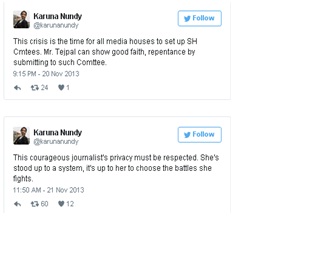 I
hope you realise that in this“noble” race you have been actively
complicit in the event of a man being thrown into jail – without a
trial – purely on the basis of the accusation of assault. You have
allowed the most ludicrous comparisons to be made between him and
violent rapists. You must be supremely self-indulgent and deeply
un-empathetic not to imagine the anguish and bewilderment you would have
caused Tejpal’s parents, daughters, relatives and friends. The
systematic public humiliation of a person has been wildly out of
balance.”
Madhu Trehan
I
hope you realise that in this“noble” race you have been actively
complicit in the event of a man being thrown into jail – without a
trial – purely on the basis of the accusation of assault. You have
allowed the most ludicrous comparisons to be made between him and
violent rapists. You must be supremely self-indulgent and deeply
un-empathetic not to imagine the anguish and bewilderment you would have
caused Tejpal’s parents, daughters, relatives and friends. The
systematic public humiliation of a person has been wildly out of
balance.”
Madhu Trehan, Editor-in-Chief of News Laundry chose to
support Tejpal
based on a video which showed that the victim supposedly exited the
elevator calmly. Ms. Trehan seems to be watching way too many Bollywood
movies to think EVERY raped woman will be screeching and crying hoarse
immediately after the act like those dainty celluloid heroines.
As an aside, Madhu Trehan wrote a book,
Tehelka as Metaphor admiring
Tehelka’s brand of journalism.
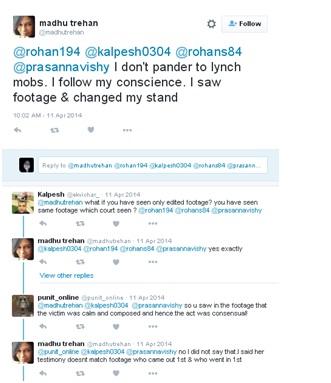

As per this
Mumbai Mirror article, Tejpal loved to gossip and had very low respect for dignity of women and specially those who were his subordinates.
“
He was also getting a seedy reputation for talking
loosely about the sex lives of people he knew and for brushing aside
sexual harassment complaints. One of his former
colleagues, who quit journalism after an incident in which the
Tejpal-Chaudhury duo played a questionable role, remembers the
indifference with which he treated her sexual harassment complaint
against a colleague who had circulated pictures of her exposed midriff
all around the office.
Fourteen years on, this former journalist still remembers her
shock when Chaudhary came up to her with a message from Tejpal that her
complaint wouldn’t go down well with the management and that she should
settle for a letter of apology. She had no choice but to
accept the apology, but she quit in disgust when her colleague got a
promotion a few months later. Today, this former journalist finds an
uncanny resemblance between Chaudhary’s behaviour in her case and his
response to the Goa grope fest – the only difference is that she’s no
longer a gullible newbie.” (emphasis added)
Another veteran member of the LAAL brigade
Bachi Karkaria chose to resurrect Tejpal’s career in 2014 by inviting him as a speaker for the Times of India’s Lit Fest only to drop it after it caused a Twitter uproar where senior journalists like
Swapan Dasgupta declined to attend if Tejpal was given a platform.
Bachi tweeted “We have asked Tarun Tejpal to drop out of the
TOI Litfest. We’ve got a great program & we don’t want it hijacked
by extraneous noise”.Indeed, Bachi was more worried about the “extraneous noise” rather than being caught supporting Tejpal, an alleged rapist.
In effect, what the
Times of India actually conveyed to its readers was this: we don’t believe in practicing what we publish in our newspapers.
End Note
You are no feminist if your reaction to rape depends upon the
religion of the victim or perpetrator or the power of the perpetrator in
the organization or the political situation in the country.
In each of the sexual abuse cases mentioned in this essay, the victim
was an educated, working and independent woman except for Tutuki. Yet
each one was let down by the same people they were led to believe in.
The media, the Op-ed writers and the feminists who churn out reams of
typed paper or yell in shrieking tones on TV debates when people who
are not aligned with their politics and ideology commit rapes. These
same people suddenly grow quiet when the perpetrator is one of their
own. Their pens run out of ink. They develop a strange malady that robs
them of their voice. One is tempted to pool funds for their medical
treatment so that they can get their voice back to defend their
sisters.
Feminists have a severe case of Dhimmitude on burqa when compared to Hindu traditions and festivals like Raksha bandhan and Karva Chauth.
Arundhati Roy claims
“coercing a woman out off burqa is as bad as coercing her into one”
while feminists claim the Hindu concept of protection (sic
Rakshabandhan) implies “
Women who fail the test of patriarchal
morality; women whose caste and class identity does not spell sexual
“respectability,” fall outside the embrace of protection”.
How does a regressive practice of one religion become acceptable
while a celebration of the relationship between a brother and sister
become patriarchal? In the cases presented above, five of them feature
Muslim perpetrators but we’ve never heard any sound bytes from the LAAL
brigade on how their religious scripture might be affecting their moral
choices.
Feminism as practiced by the LAAL group is a dichotomous construct
with one set of rules for the men belonging to their side and another
for the Hindu man.
The LAAL cabal practices opportunistic feminism while
brainwashing young girls with empty concepts of women’s liberation and
women’s rights.
Karva Chauth is labeled as a regressive construct by the mainstream
media and women practicing it are treated as pariahs while forcing
Muslim women into the Burqa is labelled as “minorities should be free to
follow their religious practices” and allied airbrushing.
Leftist feminist women and their cohorts in the media seem to be
caught in the Stockholm syndrome when it comes to fighting sexual
harassment in their side. It is only a matter of time before their
hatred and self-loathing consumes them.
The author is an academic, specialist in Civil Engineering, and entrepreneur and classical music aficionado

